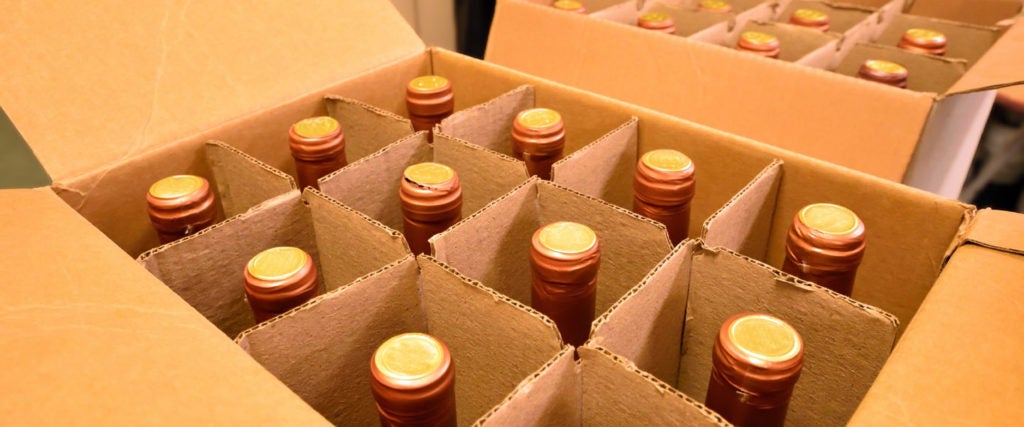Perhaps it’s my rube palate, but I’ve never found spending much more than necessary to be worth it, booze-wise. I understand some basic phrases signifying purity and quality — “100 percent agave,” “seven-times filtered,” etc. — and usually purchase the cheapest of liquors bearing them. But selecting a wine is a truly Delphic process. Their labels are meaningless beyond identifying which grapes they contain or their region, otherwise obscured by things like abstract portraiture, gold-foiled raised font and the French language.
As someone who loathes meaninglessly overpaying for things, buying wine is, at best, anxiety inducing. In theory, then, I am precisely the type of person for whom the mail-order wine subscription is for — someone who doesn’t even want the option of choosing a bottle of their own but wants the thrill of something new. But I absolutely refuse to let them get me to overspend, either.
In the last two months, I have acquired 21 bottles of wine via mail-order subscription and spent around $35. Not even the Two-Buck Chuck at Trader Joe’s can compete with that price. Is the wine of a higher quality than that? As I suggested before, I have absolutely no fucking clue, but that’s besides the point anyway: I spent $1.66 per bottle. So long as it gets me tipsy, I’m sure I got my money’s worth.
How’d I get such a deal?
By being a complete rebate freak.
I say I spent $35, but that’s in gross cost. Out-of-pocket, I spent $120 split between two purchases of $29.99 and $90. Within a few days of each of those purchases, though, I’d already recouped some of my money by making my purchases thanks to said rebates and rewards apps.
For the first, I used Drop, an app through which you can accumulate points by making purchases with linked credit cards or by shopping through the app itself. Drop typically offers a varying number of points per dollar spent at a variety of stores, and the points you accrue can be redeemed for gift cards. Often, they offer larger lump-sums for signing up for subscription services, including the wine subscription Firstleaf.
I’d heard of Firstleaf before, tried out its quiz once or twice and had been on the fence about ordering. They usually offered their first box of six bottles for the reduced price of $39.99 — on Drop, you could usually get around 10,000 to 15,000 points, the equivalent of $10 to $15, for signing up through the app. In an alignment of the discount-lovers’ stars, however, Firstleaf temporarily reduced their first box price to $29.99 just as Drop was offering 40,000 points for new customers. To get to the point, I ultimately got a box of six wines and made $10 from it. Those 40,000 points will need to be redeemed as a gift card, but with Amazon, Sephora and Dunkin among the options, this isn’t much of an issue for me.
Absolutely buzzing from the thrill of such a deal, I went hunting for more. Without any other head-turning offerings on Drop, I began looking through what rebate app Rakuten could provide. There, I saw an offer for $45 cash back on new subscriptions from Wine Insiders. I wasn’t familiar with Wine Insiders, and the site seemed more for an older audience than the hipper online wine sites like Winc, Bright Cellars or Firstleaf. Fine by me! Upon perusing the Wine Insiders site, I saw that they, too, had a solid introductory offer, with 15 bottles going for $90. Better yet, through Rakuten, that $90 became $45. I got my rebate the very next day, and that money automatically goes into my Paypal account. They have a direct deposit option, too, for those who prefer it.
Of course, there are some important caveats to this deal hunting. For both Firstleaf and Wine Insiders, I was signing up for a subscription service. Were I to not cancel my subscription, I would automatically be charged full price, $79.99 and $150. It’d be easy to forget about this and neglect to cancel in time, so devoted deal heads will need to be careful, mark their calendars and cancel accordingly. There’s also the question of quality, one that I truly cannot freaking answer. I’ve had eight of the bottles so far, split with my mother and the singular friend outside of my household I see. None of us have complained.
On Firstleaf, many of the bottles are only available through them. Since you can’t buy them in stores, it’s hard to compare them in terms of price or quality. They could be slapping a pretty picture of an owl on some sewer wine. Considering how nearly every wine manufacturer obfuscates their contents, regardless of where you purchase, I’m unbothered by that gamble. Wine Insiders, meanwhile, sells wines that can be found elsewhere, and as such, they sometimes show their hand. One review posted by a customer on Consumer Advocate wrote how a bottle they received, “Freschello Vino Bianco,” is actually an extremely cheap supermarket wine sold in Italy. In U.S. dollars, it goes for around $2.50. So, maybe I really only saved a buck on a couple of these wines, but again, I’m unbothered: I want to drink what thrifty Italians drink!
My boyfriend’s brother is a sommelier. He even took us on a trip to several wineries in Napa, where I tasted some of the best wines this country has to offer. While I’m sure he could easily taste the difference in quality between those wines and the ones that have arrived in a dusty box to my doorstep, I genuinely cannot. Maybe soon I’ll get on my Boomer vibes and sign up for the Wall Street Journal’s wine club. They seem to have a solid introductory offer — I’ll just have to wait for a good rebate offer to come up.

